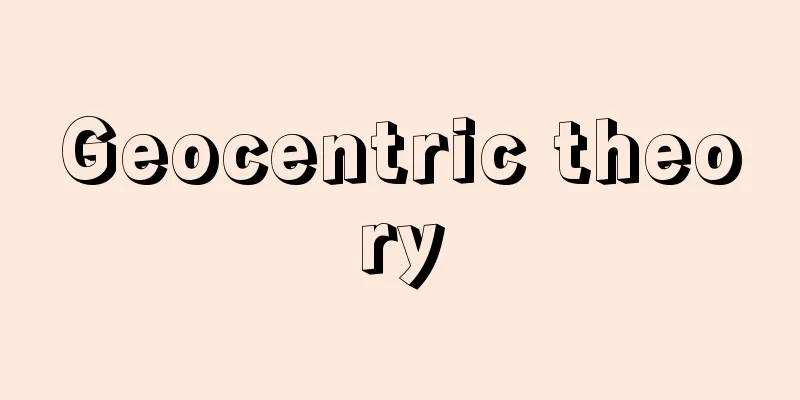Geocentric theory

|
A cosmic model in which the Earth stands still at the center of the universe, with the Moon, Sun, five planets, and various fixed stars revolving around it on their own celestial spheres. Geocentric theory. It can be said to be a view of the universe in which primitive man intuitively and emotionally saw the Earth as fixed and the sky as rotating. Ancient cosmologies such as the Egyptian and Chaldean vault theory, the Indian Mount Meru theory, the Chinese covered sky theory, and the Greek circular orbit theory are cosmologies that incorporate geometric or kinetic considerations. In particular, the Greek geocentric theory was originally an idealistic cosmic model, but the model was revised one after another to match the celestial phenomena experienced in reality, and eventually came to exhibit an extremely complex and intricate structure. The origin of the geocentric theory is the Pythagorean cosmos (ordered universe). Its basic principles are perfection (sphericity), dignity (center), constancy (uniform speed), and harmony (simple ratios). Plato adopted Apollonius' eccentric theory, which removed the Earth from the center of the orbit of the uniform circular motion of the Moon and the Sun to explain their slow motion. Aristotle adopted Eudoxus' concentric sphere theory, which gave each planet multiple celestial spheres and synthesized each rotation to rationalize the retrograde motion of the planets. The completed form of the geocentric theory was the epicycle theory of Ptolemy in the 2nd century AD. By placing the planets on epicycles that revolve around the principal circumference with the Earth at the center, the planet's orbit draws a loop curve as a synthesis of two types of uniform circular motion. This theory lacked mechanical considerations, but it was supported by the effectiveness of calendar calculation methods and the authority of Christian doctrine and became the accepted theory until the 16th century. [Shimamura Fukutaro] "Almagest" by Ptolemy, translated by Yabuuchi Kiyoshi (1958, Koseisha Kouseikaku)" ▽ "The Progress of Cosmology" by Sharon, translated by Nakayama Shigeru (1971, Heibonsha)" ▽ "Ancient Cosmology, edited by Brucker and Rowe, translated by Yajima Yuri and Yajima Fumio (1976, Kaimeisha)" [Reference items] | | theorySource: Shogakukan Encyclopedia Nipponica About Encyclopedia Nipponica Information | Legend |
|
宇宙の中心に地球が静止し、その周囲で月、太陽、五惑星、諸恒星が各個別の天球上を公転するという宇宙模型。地球中心説。原始人が直観的・情緒的に、大地は固定し、大空が回転すると見立てた宇宙観といえる。古代でのエジプト・カルデアの丸天井説、インドの須弥山(しゅみせん)説、中国の蓋天(がいてん)説、ギリシアの円形軌道説などは、幾何学的ないし運動学的考察を加えた宇宙論である。とくにギリシアにおける天動説は、初め理念的に空想した宇宙模型であったが、実地に経験した天体現象に合致させるべく次々とその模型を改定していき、ついにはきわめて複雑・技巧的な構造を呈するに至った。 天動説の原型はピタゴラスのコスモス(秩序宇宙)である。その基本理念は、完全性(球形)、尊厳性(中心)、恒常性(等速)、調和性(単純比)である。プラトンは、月および太陽の遅速運行を説明するために、その等速円運動の軌道中心から地球を外すというアポロニオスの離心円説を採用した。またアリストテレスは惑星の逆行を合理化するために、1個の惑星に数重の天球を設け、各回転を合成するというエウドクソスの同心球説を採用した。天動説の完成した形は紀元2世紀プトレマイオスの周転円説である。地球を中心とする主導円周上を転進する周転円上に惑星を置くことによって、2種の等速円運動の合成として、惑星の軌跡がループ曲線を描く仕組みである。この説には力学的考察を欠いていたが、暦推算法の有能性と、キリスト教義の権威とに支えられて16世紀まで定説化した。 [島村福太郎] 『プトレマイオス著、藪内清訳『アルマゲスト』(1958・恒星社厚生閣)』▽『シャロン著、中山茂訳『宇宙論の歩み』(1971・平凡社)』▽『ブラッカー、ローウェ編、矢島祐利・矢島文男訳『古代の宇宙論』(1976・海鳴社)』 [参照項目] | |出典 小学館 日本大百科全書(ニッポニカ)日本大百科全書(ニッポニカ)について 情報 | 凡例 |
<<: Transmission device - Electrical equipment
Recommend
Akabana (fish) - Akabana
...Also, yellowtails are called yellowtails becau...
Pythagoras
An ancient Greek natural scientist, mathematician...
Shinminato [city] - Shinminato
An old city in the north of Toyama Prefecture. In ...
Umatilla Tangor - Umatilla Tangor
…Some varieties that are said to have been create...
Cambiata
…(5) Anticipation: This is the case when the harm...
Oston's Owl - Oston's Owl
...They are found south of Sagami Bay at depths o...
"Kawanakajima War Chronicles"
...One of the highlights is the exploits of Yamam...
Rh(a)eto‐Romance
A Romance language spoken in the Alps and the Friu...
Amazaki Castle Ruins
...In 1979, the Omishima Bridge (328m) was opened...
Myrmecophyte (ant plant)
This plant is said to have a symbiotic relationshi...
Abahi - Abahi (English spelling) avahi
It is an animal of the Indriidae family in the Pr...
IgD
《 immunoglobulin D 》⇒ immunoglobulin D Source: Abo...
Crane Trick - Crane Trick
...The wings have finely branched veins at the ti...
Amylopectin
…Refined starch is a white powder that is tastele...
Oak - Quercus spp.
A general term for deciduous species of tall trees...









